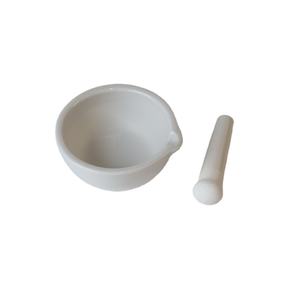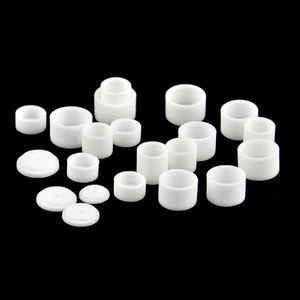1. The Product Structure and Crystallographic Identification of Alumina Ceramics
1.1 Atomic Architecture and Stage Stability
(Alumina Ceramics)
Alumina porcelains, primarily made up of aluminum oxide (Al two O SIX), represent among the most extensively made use of classes of sophisticated ceramics because of their extraordinary balance of mechanical toughness, thermal resilience, and chemical inertness.
At the atomic level, the efficiency of alumina is rooted in its crystalline framework, with the thermodynamically secure alpha phase (α-Al two O â) being the dominant type used in design applications.
This stage takes on a rhombohedral crystal system within the hexagonal close-packed (HCP) latticework, where oxygen anions create a dense arrangement and aluminum cations inhabit two-thirds of the octahedral interstitial sites.
The resulting structure is extremely stable, adding to alumina’s high melting factor of about 2072 ° C and its resistance to decay under severe thermal and chemical conditions.
While transitional alumina phases such as gamma (Îł), delta (ÎŽ), and theta (Ξ) exist at lower temperature levels and display higher surface areas, they are metastable and irreversibly transform into the alpha phase upon heating above 1100 ° C, making α-Al two O â the unique stage for high-performance architectural and useful components.
1.2 Compositional Grading and Microstructural Engineering
The residential properties of alumina porcelains are not dealt with but can be tailored with regulated variants in purity, grain size, and the addition of sintering help.
High-purity alumina (â„ 99.5% Al Two O THREE) is employed in applications requiring optimum mechanical strength, electrical insulation, and resistance to ion diffusion, such as in semiconductor processing and high-voltage insulators.
Lower-purity grades (varying from 85% to 99% Al â O â) commonly integrate additional stages like mullite (3Al â O TWO · 2SiO â) or lustrous silicates, which enhance sinterability and thermal shock resistance at the expense of hardness and dielectric efficiency.
An essential factor in performance optimization is grain size control; fine-grained microstructures, achieved via the enhancement of magnesium oxide (MgO) as a grain growth inhibitor, considerably boost crack strength and flexural toughness by limiting split breeding.
Porosity, even at reduced levels, has a harmful impact on mechanical integrity, and completely dense alumina ceramics are typically produced using pressure-assisted sintering strategies such as hot pushing or hot isostatic pushing (HIP).
The interplay in between make-up, microstructure, and processing specifies the functional envelope within which alumina porcelains run, enabling their use across a large spectrum of industrial and technical domains.
( Alumina Ceramics)
2. Mechanical and Thermal Efficiency in Demanding Environments
2.1 Strength, Hardness, and Wear Resistance
Alumina ceramics display an one-of-a-kind mix of high solidity and moderate fracture sturdiness, making them ideal for applications entailing abrasive wear, disintegration, and effect.
With a Vickers firmness typically ranging from 15 to 20 GPa, alumina rankings among the hardest engineering materials, surpassed just by diamond, cubic boron nitride, and specific carbides.
This severe solidity translates into phenomenal resistance to damaging, grinding, and bit impingement, which is exploited in components such as sandblasting nozzles, reducing tools, pump seals, and wear-resistant linings.
Flexural toughness values for dense alumina variety from 300 to 500 MPa, relying on purity and microstructure, while compressive stamina can go beyond 2 GPa, permitting alumina parts to endure high mechanical loads without contortion.
Despite its brittleness– a common quality amongst ceramics– alumina’s efficiency can be enhanced via geometric style, stress-relief functions, and composite reinforcement methods, such as the incorporation of zirconia bits to cause transformation toughening.
2.2 Thermal Behavior and Dimensional Stability
The thermal homes of alumina ceramics are main to their use in high-temperature and thermally cycled settings.
With a thermal conductivity of 20– 30 W/m · K– more than the majority of polymers and similar to some steels– alumina successfully dissipates heat, making it appropriate for warmth sinks, insulating substrates, and heating system components.
Its low coefficient of thermal development (~ 8 Ă 10 â»â¶/ K) guarantees marginal dimensional adjustment throughout heating & cooling, decreasing the threat of thermal shock breaking.
This stability is especially beneficial in applications such as thermocouple protection tubes, spark plug insulators, and semiconductor wafer handling systems, where exact dimensional control is essential.
Alumina maintains its mechanical stability up to temperature levels of 1600– 1700 ° C in air, past which creep and grain limit moving may initiate, relying on purity and microstructure.
In vacuum cleaner or inert atmospheres, its efficiency prolongs even better, making it a favored material for space-based instrumentation and high-energy physics experiments.
3. Electrical and Dielectric Features for Advanced Technologies
3.1 Insulation and High-Voltage Applications
Among the most substantial functional attributes of alumina ceramics is their impressive electric insulation capability.
With a volume resistivity going beyond 10 Âč⎠Ω · cm at room temperature and a dielectric toughness of 10– 15 kV/mm, alumina acts as a trustworthy insulator in high-voltage systems, consisting of power transmission devices, switchgear, and digital product packaging.
Its dielectric continuous (Δᔣ â 9– 10 at 1 MHz) is fairly secure across a large frequency variety, making it ideal for usage in capacitors, RF parts, and microwave substrates.
Reduced dielectric loss (tan ÎŽ < 0.0005) guarantees minimal power dissipation in rotating existing (AC) applications, boosting system effectiveness and reducing heat generation.
In published circuit card (PCBs) and hybrid microelectronics, alumina substratums supply mechanical support and electrical seclusion for conductive traces, enabling high-density circuit combination in rough environments.
3.2 Efficiency in Extreme and Sensitive Environments
Alumina porcelains are distinctly fit for usage in vacuum, cryogenic, and radiation-intensive atmospheres due to their low outgassing prices and resistance to ionizing radiation.
In fragment accelerators and fusion reactors, alumina insulators are made use of to separate high-voltage electrodes and diagnostic sensors without introducing impurities or breaking down under prolonged radiation exposure.
Their non-magnetic nature additionally makes them suitable for applications entailing solid magnetic fields, such as magnetic resonance imaging (MRI) systems and superconducting magnets.
Additionally, alumina’s biocompatibility and chemical inertness have actually resulted in its adoption in clinical gadgets, consisting of oral implants and orthopedic parts, where long-term security and non-reactivity are extremely important.
4. Industrial, Technological, and Arising Applications
4.1 Role in Industrial Machinery and Chemical Processing
Alumina porcelains are thoroughly used in commercial equipment where resistance to wear, deterioration, and heats is crucial.
Elements such as pump seals, valve seats, nozzles, and grinding media are generally fabricated from alumina due to its ability to stand up to unpleasant slurries, aggressive chemicals, and elevated temperature levels.
In chemical handling plants, alumina cellular linings shield activators and pipes from acid and antacid strike, prolonging devices life and reducing upkeep prices.
Its inertness likewise makes it suitable for usage in semiconductor fabrication, where contamination control is crucial; alumina chambers and wafer watercrafts are revealed to plasma etching and high-purity gas environments without seeping contaminations.
4.2 Integration right into Advanced Production and Future Technologies
Beyond typical applications, alumina porcelains are playing an increasingly vital function in emerging modern technologies.
In additive production, alumina powders are made use of in binder jetting and stereolithography (SHANTY TOWN) refines to produce facility, high-temperature-resistant parts for aerospace and power systems.
Nanostructured alumina movies are being checked out for catalytic supports, sensors, and anti-reflective finishings as a result of their high surface area and tunable surface chemistry.
Additionally, alumina-based compounds, such as Al â O â-ZrO â or Al â O â-SiC, are being created to overcome the intrinsic brittleness of monolithic alumina, offering improved toughness and thermal shock resistance for next-generation structural products.
As sectors remain to push the limits of performance and integrity, alumina porcelains continue to be at the center of product technology, bridging the space in between structural effectiveness and functional convenience.
In summary, alumina ceramics are not simply a course of refractory products but a cornerstone of modern engineering, enabling technological development throughout power, electronic devices, health care, and industrial automation.
Their distinct combination of properties– rooted in atomic framework and fine-tuned through advanced handling– guarantees their ongoing significance in both developed and arising applications.
As product science develops, alumina will most certainly remain a vital enabler of high-performance systems operating beside physical and ecological extremes.
5. Supplier
Alumina Technology Co., Ltd focus on the research and development, production and sales of aluminum oxide powder, aluminum oxide products, aluminum oxide crucible, etc., serving the electronics, ceramics, chemical and other industries. Since its establishment in 2005, the company has been committed to providing customers with the best products and services. If you are looking for high quality alumina technology, please feel free to contact us. (nanotrun@yahoo.com)
Tags: Alumina Ceramics, alumina, aluminum oxide
All articles and pictures are from the Internet. If there are any copyright issues, please contact us in time to delete.
Inquiry us

